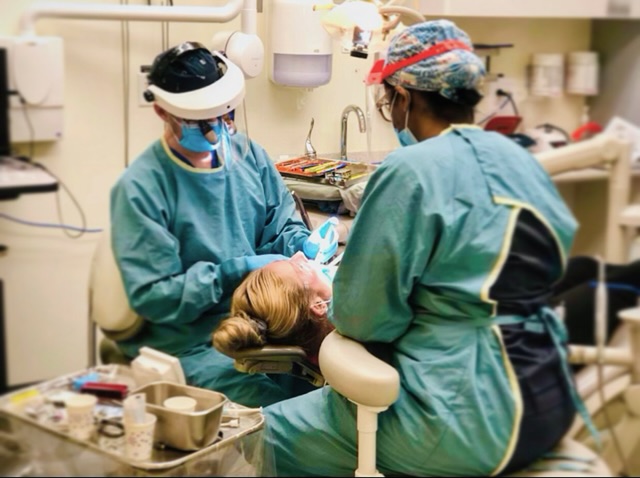Co-learning initiative gives dentistry students a head start in clinical care
Danica Erickson - 2 November 2022

In September of 2019, the School of Dentistry at the University of Alberta realized a long-standing goal: A newly revised curriculum that would give first- and second-year dental students the opportunity to shadow seniors learners in the school’s Oral Health Clinic. It was a big step for the learners and the school, and when the COVID-19 pandemic hit, it paved the way for co-learning, a new way to provide clinical dental education.
The co-learning project began in fall 2020 to support the additional infection prevention and control measures that had been put in place in the Oral Health Clinic during the pandemic. “We had always wanted the first- and second-year students to be in the clinic earlier, and although the new curriculum allowed for them to do more shadowing of senior students in the clinic, it became very obvious that we really needed the junior students to not only shadow but to actually become part of the clinical team and to be chair-side on a regular basis during the pandemic,” recalls Anthea Senior, associate professor and associate chair of doctor of dental surgery clinical education.
When the 2020 school year began, all dental students were given online training about the new infection-control measures. First- and second-year students also received chair-side assistance training from the registered dental assistants on staff and the third- and fourth-year students were prepared to welcome their junior colleagues into the clinic. Although the first-year co-learners didn’t perform any procedures until later on in the year, they spent time talking to patients and observing. This gave them valuable exposure to real-life patient situations that they were learning about in classrooms and simulation settings. They also got experience using electronic health records and became familiar with common protocols and procedures.
When appropriate, second-year co-learners performed some procedures on patients, such as administering local anesthesia, applying rubber dams and scaling. The senior students appreciated the assistance not only with tasks such as suction of aerosols and retraction of the soft tissues, but also with setup and clean-up, data entry and taking radiographs.
To enhance the learning experience, the program worked with an educational consultant to put together a reflection assignment for the students. Reflection assignments are commonly used in post-secondary learning environments to help learners develop a deeper understanding of their learning experiences. Reflection helps students identify their own strengths and weaknesses so they know what further study they need. Self-reflection is an important part of professional development, so it’s a skill that dentistry students can carry forward with them into their professional practice.
While it’s encouraging for students to have first-hand experience with the benefit of the work earlier in their training, Senior believes it’s also beneficial for the clinic’s patients. For example, experienced dentists routinely talk to and reassure their patients while they are working; it’s a normal part of the job and a skill they develop over time. The same is not true for dental students. “Learner dentists have to think about a lot of things when they're doing a procedure, especially if it's something complex, or that they haven't done before,” Senior points out. So while a third- or fourth-year dental student performing a procedure for the first time has to really concentrate, the first- and second-year co-learners have the time to talk to patients and put them at ease. Senior notes that this is especially helpful for the older adult patients, many of whom really enjoy the opportunity to talk with the students.
The junior co-learners also get early exposure to see the positive impact of dentistry on people’s lives, such as the transformation in a patient’s appearance, confidence and self-esteem when they have their anterior teeth restored or a new pair of dentures fitted.
The co-learning program has turned out to be good for everyone, not just patients. The program’s support staff and instructors enjoyed getting to know the junior students earlier in their education. Mentorship and peer teaching occurred between the students and this helped to create new friendships between students in different years of the program.
Although it has been a big change, Senior describes the new way of doing things as win-win. “Co-learning really helped the junior students see how their lecture and lab learning applies to the clinical setting and helps to get them ready for providing patient care,” she says “Something that was survival has really turned into success.”